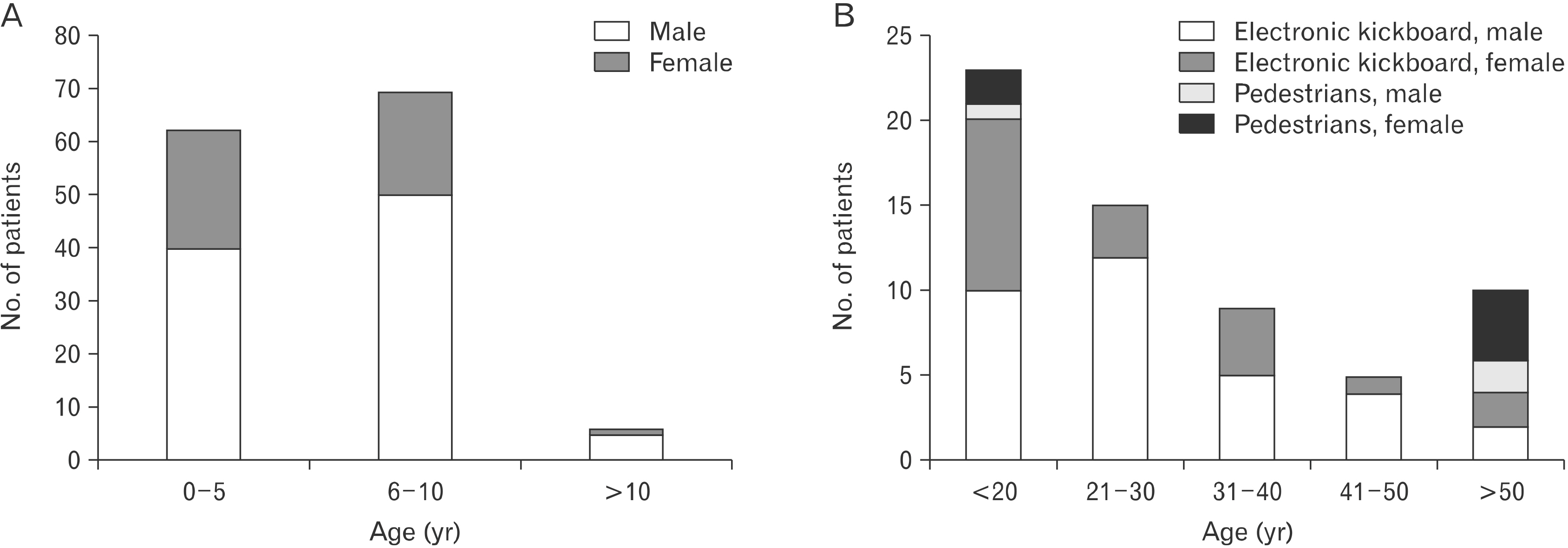Korean J Sports Med.
2021 Dec;39(4):154-159. 10.5763/kjsm.2021.39.4.154.
The Characteristics of Nonmotorized and Electric Kickboard Injury: Retrospective Analysis from a Single Tertiary Institution
- Affiliations
-
- 1Department of Orthopedic Surgery, Keimyung University Dongsan Hospital, Keimyung University School of Medicine, Daegu, Korea
- KMID: 2523230
- DOI: http://doi.org/10.5763/kjsm.2021.39.4.154
Abstract
- Purpose
Recently, there has been an increasing number of kickboard injuries at our orthopedic clinic and emergency room. Therefore, this study is to identify the incidence and characteristics of nonmotorized and electric kickboard injuries with emergency room surveillance.
Methods
Between August 2018 and January 2021, patients who visited the emergency room of a tertiary hospital with nonmotorized and electric kickboard injuries were included. The incidence, severity, and characteristics were analyzed.
Results
There were a total of 204 patients who visited our emergency room during the study period. There were 139 nonmotorized kickboard injuries with 115 minor, 11 moderate, and 13 severe injuries. Fifty-six electric kickboard injuries were 47 minor, one moderate, and eight severe injuries. The incidence of injury depended on-site and was as follows: face and head (63.7%), upper extremity, lower extremity, abdomen and chest, and spine.
Conclusion
Face and head injuries were the most common injuries in body part, while minor trauma was the most common diagnosis. With the increasing incidence of kickboard injuries, we should be more mindful that protective equipment and safety rules may be necessary.
Keyword
Figure
Reference
-
1. Hazard Prevention Team, Hazard Information Bureau, Korea Consumer Agency (KCA). 2020. Analysis of child safety accident trends [Internet]. KCA;Eumseong: Available from: https://www.kca.go.kr/smartconsumer/board/download.do?menukey=7301&fno=10026845&bid=00000146&did=1002946532. cited 2021 Nov 1.2. Han D, Kim E, Ji M. 2020; Analysis of severity factors in personal mobility (PM) traffic accidents. J Korean Soc Transport. 38:232–47. DOI: 10.7470/jkst.2020.38.3.232.
Article3. Korea Internet Self-Governance Organization (KISO), Planning Team. 2019; Domestic trend of 'shared electric kickboard' and its expected effect. KISO J. 36:31–6.4. Hazard Prevention Team, Hazard Information Bureau, Korea Consumer Agency (KCA). 2020. Consumer safety advisory issued to prevent electric kickboard safety accidents [Internet]. KCA;Eumseong: Available from: https://www.kca.go.kr/home/sub.do?menukey=4002&mode=view&no=1003053564&page=6. cited 2021 Nov 1.5. Gennarelli TA, Wodzin E. AIS 2005: a contemporary injury scale. Injury. 2006; 37:1083–91. DOI: 10.1016/j.injury.2006.07.009. PMID: 17092503.
Article6. Kim JH, Koh EH, Kwun SH, et al. 2002; Factors that affect accidents from riding on inline skates and/or kick boards among students in the elementary schools. Korean J Child Health Nurs. 8:381–90.7. Nathanson BH, Ribeiro K, Henneman PL. 2016; An analysis of US emergency department visits from falls from skiing, snowboarding, skateboarding, roller-skating, and using nonmotorized scooters. Clin Pediatr (Phila). 55:738–44. DOI: 10.1177/0009922815603676. PMID: 26324666.
Article8. Park HK, Park JY, Choi NR, Kim UK, Hwang DS. 2021; Sports-related oral and maxillofacial injuries: a 5-year retrospective study, Pusan National University Dental Hospital. J Oral Maxillofac Surg. 79:203.e1–8. DOI: 10.1016/j.joms.2020.07.218. PMID: 32866487.
Article9. Gaines BA, Shultz BL, Ford HR. 2004; Nonmotorized scooters: a source of significant morbidity in children. J Trauma. 57:111–3. DOI: 10.1097/01.TA.0000082156.67895.C8. PMID: 15284559.
Article10. Schalamon J, Sarkola T, Nietosvaara Y. 2003; Injuries in children associated with the use of nonmotorized scooters. J Pediatr Surg. 38:1612–5. DOI: 10.1016/S0022-3468(03)00571-2. PMID: 14614710.
Article11. Kobayashi LM, Williams E, Brown CV, et al. 2019; The e-merging e-pidemic of e-scooters. Trauma Surg Acute Care Open. 4:e000337. DOI: 10.1136/tsaco-2019-000337. PMID: 31565677. PMCID: PMC6744075.
Article12. Blomberg S, Rosenkrantz O, Lippert F, Collatz Christensen H. 2019; Injury from electric scooters in Copenhagen: a retrospective cohort study. BMJ Open. 9:e033988. DOI: 10.1136/bmjopen-2019-033988. PMID: 31871261. PMCID: PMC6936991.
Article13. Lee JB, Lee JS. 2019. A study on the vibrotactile feedback to support user's perception of driving speed of electric kick board. Proceeding of HCI Korea 2019; 2019 Feb 13-16; Jeju, Korea. HCI Society of Korea;Seoul: p. 240–4.14. Lindsay H, Brussoni M. 2014; Injuries and helmet use related to non-motorized wheeled activities among pediatric patients. Chronic Dis Inj Can. 34:74–81. DOI: 10.24095/hpcdp.34.2/3.02. PMID: 24991770.
Article
- Full Text Links
- Actions
-
Cited
- CITED
-
- Close
- Share
- Similar articles
-
- Epidemiologic study of hand and upper extremity injuries by power tools
- Clinical Characteristics of Electric Cataract
- A Clinical Analysis of Friction Burns Caused by Electric Scooters
- Clinical Analysis of Trauma Characteristics Among Preschool-Aged Children
- Sports-Related Dental Injuries in the Pediatric Patient: A Retrospective Study


